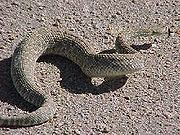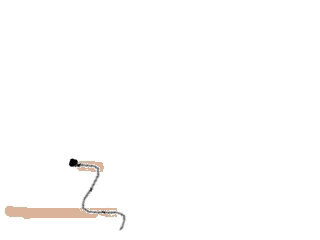
Sidewinding
Encyclopedia

Snake
Snakes are elongate, legless, carnivorous reptiles of the suborder Serpentes that can be distinguished from legless lizards by their lack of eyelids and external ears. Like all squamates, snakes are ectothermic, amniote vertebrates covered in overlapping scales...
s, used to move across loose or slippery substrates. It is most often used by the Saharan horned viper, Cerastes cerastes
Cerastes cerastes
Cerastes cerastes is a venomous viper species native to the deserts of Northern Africa and parts of the Middle East. They often are easily recognized by the presence of a pair of supraocular horns, although hornless individuals do occur. No subspecies are currently recognized.-Description:The...
, and the sidewinder rattlesnake
Rattlesnake
Rattlesnakes are a group of venomous snakes of the genera Crotalus and Sistrurus of the subfamily Crotalinae . There are 32 known species of rattlesnake, with between 65-70 subspecies, all native to the Americas, ranging from southern Alberta and southern British Columbia in Canada to Central...
, Crotalus cerastes
Crotalus cerastes
Crotalus cerastes is a venomous pitviper species found in the desert regions of the southwestern United States and northwestern Mexico. Three subspecies are currently recognized, including the nominate subspecies described here.-Description:...
, to move across loose desert sands, but it is also used by Homalopsine
Homalopsinae
Homalopsinae is a subfamily of Colubridae which contains some 10 genera and about 4 dozen species. They are typically stout-bodied water snakes, and all are mildly venomous. The genus Brachyorrhos may belong elsewhere...
snakes in Southeast Asia
Southeast Asia
Southeast Asia, South-East Asia, South East Asia or Southeastern Asia is a subregion of Asia, consisting of the countries that are geographically south of China, east of India, west of New Guinea and north of Australia. The region lies on the intersection of geological plates, with heavy seismic...
to move across tidal mud flats. Any number of caenophidian snakes can be induced to sidewind on artificial smooth surfaces, though difficulty in getting them to do so and their proficiency at it vary greatly.
The method of movement is derived from lateral undulation, and is very similar, in spite of appearances. A picture of a snake performing lateral undulation would show something like a sine wave
Sine wave
The sine wave or sinusoid is a mathematical function that describes a smooth repetitive oscillation. It occurs often in pure mathematics, as well as physics, signal processing, electrical engineering and many other fields...
, with straight segments of the body having either a positive or negative slope. Sidewinding is accomplished by simply lifting all the segments with the same slope off the ground.
In the resultant movement, the snake's body is always in static (as opposed to sliding) contact when touching the ground. The head seems to be "thrown" forward, and the body follows, being lifted from the prior position and moved forward to lie on the ground ahead of where it was originally. Meanwhile, the head is being thrown forward again. In this way, the snake slowly progresses at an angle, leaving a series of mostly straight, J-shaped tracks. Because the snake's body is in static contact with the ground, imprints of the belly scales can be seen in the tracks, and each track is almost exactly as long as the snake.
Below is a crude animated line-drawing showing the locomotor pattern of sidewinding. The light brown areas are the tracks left behind, and also indicate where the body of the snake touched the ground.

Note that you can determine the line of movement by drawing a line connecting either the right or left tips of the tracks.

